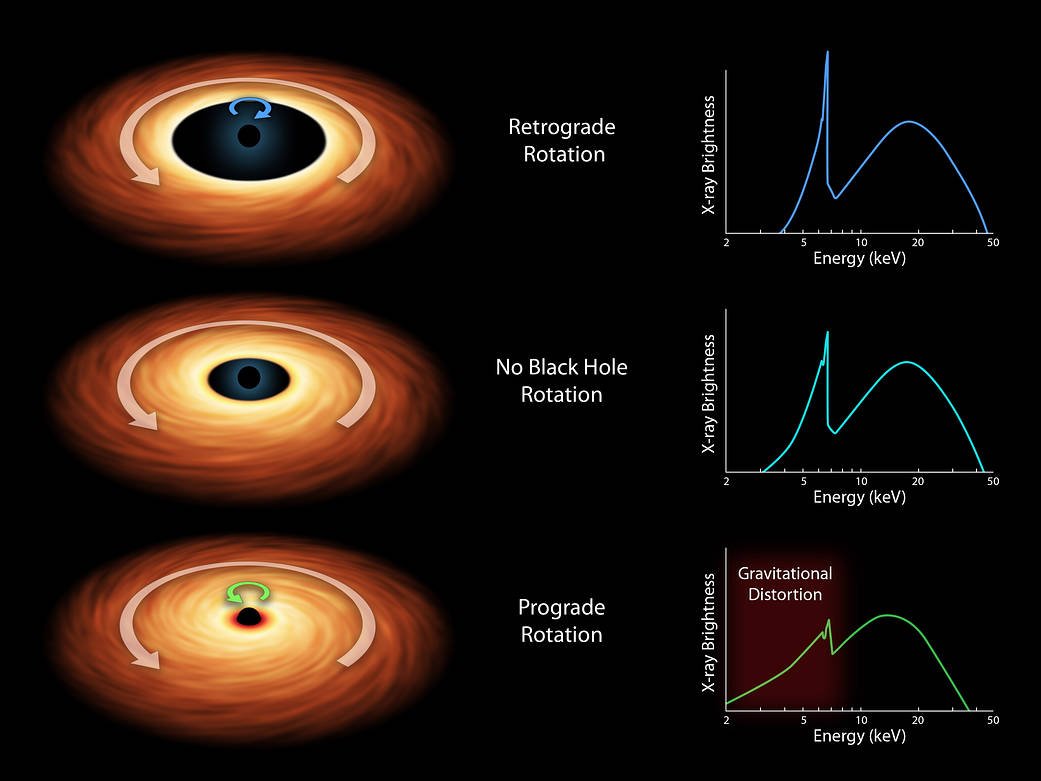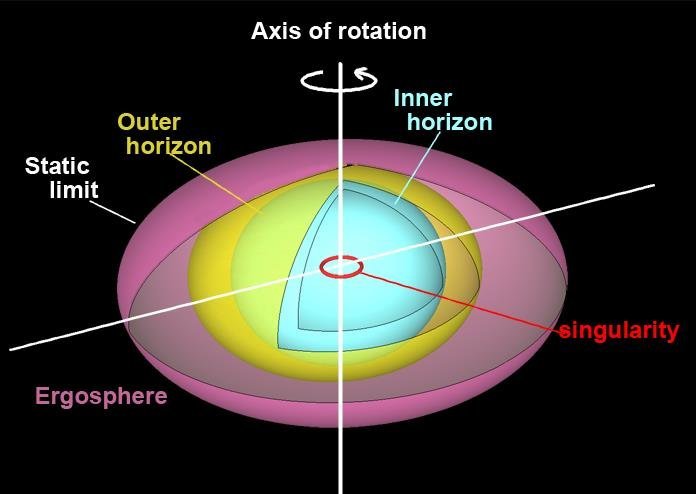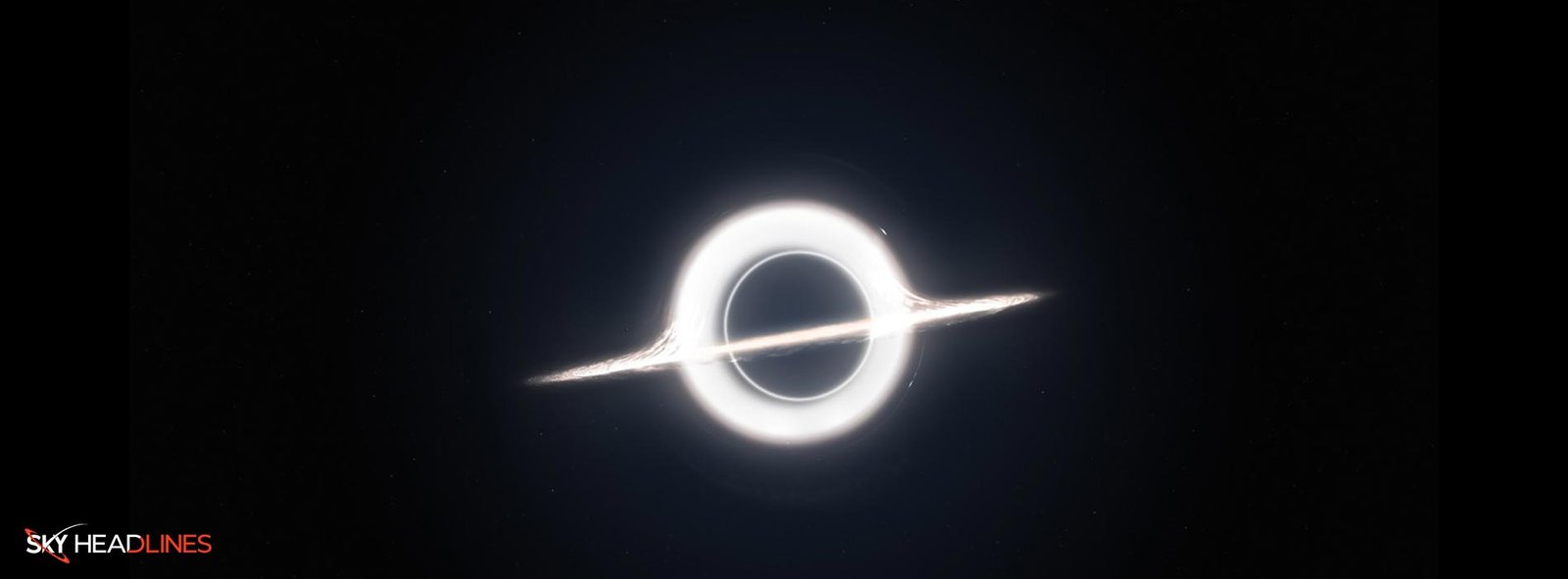Kerr Black Holes: A Complete Guide
Let’s talk about Kerr black holes, the universe’s spinning marvels. Discovered by Roy Kerr in 1963, these black holes have quite a unique character. Instead of just a point singularity at the center, they feature a ring-shaped one. That’s right—a ring! And don’t get us started on the ergosphere, a zone where the black hole’s rotation actually drags space-time along. It’s like walking into a room and having the wallpaper swirl around you!
Properties of Kerr Black Holes
When it comes to Kerr black holes, we’re essentially looking at three vital stats: mass, angular momentum, and electric charge. Think of the mass as the black hole’s “size,” determining the dimensions of its event horizon. Angular momentum affects the ergosphere, making it one of the most intriguing features. As for the electric charge, well, it’s more or less negligible. Unlike a perfect sphere, a Kerr black hole’s event horizon is more like a squished ball. Why? Because it’s spinning so fast that it actually bulges at its equator!
Formation of Kerr Black Holes
So how do these spinning black holes come into existence? The most popular route involves a massive star exhausting its nuclear fuel, leading to a cosmic collapse. If that star has the right dance moves—i.e., it’s spinning—it gives birth to a Kerr black hole. But wait, there’s another way. When two neutron stars decide they can’t live without each other and merge, their union could be so intense that it results in a Kerr black hole. The faster these love-struck neutron stars were spinning before they met, the faster the resulting black hole will spin.
Detection of Kerr Black Holes
You might think finding a black hole that emits no light is like finding a needle in a haystack—impossible! But it’s actually quite doable. For one, these black holes have a tendency to make other objects wobble because of their immense gravity. So, if you see a star wobbling suspiciously, you might be witnessing a Kerr black hole’s gravitational pull. Another way is to look at X-rays emitted by matter heated up in the ergosphere. These X-rays are like the black hole saying, “Hey, look at me!” And let’s not forget the Penrose process, where a Kerr black hole acts like a cosmic particle accelerator, adding another layer of mystery and awe to these fascinating celestial objects.
Implications of Kerr Black Holes
The fascinating world of Kerr black holes isn’t just a feast for the eyes (if you could actually see them, that is), but also a treasure trove of knowledge that can alter how we understand our very existence. Imagine unraveling the mysteries of galaxy formation or unlocking the enigmatic behaviors of gamma-ray bursts and quasars—all through the study of these rotating black holes.
Discussion
The Kerr effect isn’t just a blackboard of complex equations; it’s a whole playground where physics gets intriguingly bizarre. Take frame dragging, where a Kerr black hole essentially gives nearby objects a cosmic swirl, compelling them to rotate. The concept may sound straight out of a science fiction novel, but it could drastically redefine how we perceive black holes and their role in cosmic phenomena. We’re not just talking about invisible traps that consume everything; we’re talking about complex and interactive celestial entities that can manipulate their surroundings in unanticipated ways. From the generation of tremendous energy through the Penrose process to the acceleration of particles within the ergosphere, the implications are as astounding as they are enigmatic. So, yes, when it comes to Kerr black holes, you’re not merely staring into an abyss; the abyss is full of dynamic and confounding features that are asking to be explored.

Future Research
If you’re an aspiring physicist or even someone with a tinge of curiosity, the landscape of Kerr black holes offers an extensive and promising terrain for exploration. Scientists are keen on dissecting the ergosphere’s physics. What causes the particles to speed up in this region? How do they manage to escape the black hole’s clutches? Furthermore, researchers are buzzing about how the Kerr effect could be the powerhouse behind some of the universe’s most energetic and perplexing phenomena, like gamma-ray bursts and quasars. It’s a rapidly evolving domain where the frontiers of knowledge are continuously being pushed, offering boundless opportunities for the naturally curious.
Shape, Ergosphere, and the Penrose Process
If black holes were artists, Kerr black holes would be the Picassos. They don’t stick to the basics. The centrifugal force from their rotation reshapes them into oblate spheroids, challenging our traditional understanding of what black holes should look like. And let’s not forget their ergosphere, a boundary that’s far from static. It’s like a force field that drags space-time and everything within it. It’s in this region that the Penrose process occurs—a beautiful yet complex cosmic dance where particles extract energy from the black hole.
What is the Uniqueness of the Kerr Black Hole?
When it comes to the enigmatic cosmos, think of the Kerr black hole as a unique fingerprint in a universe full of palm prints. What sets it apart is its ability to rotate while keeping its event horizon—essentially its point of no return—completely stationary. Imagine a ballet dancer spinning in place, her arms creating an invisible boundary that nothing could penetrate or escape. She would be the epitome of a Kerr black hole, an object so special that it’s the only one of its kind to solve Einstein’s complicated equations in this particular manner. The Kerr black hole isn’t just another celestial object; it’s the standard by which all other rotating black holes can be understood.
What is the Inner Horizon of a Kerr Black Hole
Deep within a Kerr black hole, beyond its event horizon, lies another captivating feature called the inner horizon. It’s as if you’ve already crossed the castle’s outer wall, only to find an inner sanctum that’s even more impenetrable. And while the mathematics to explain it is complex, with equations like think of it as a boundary you would not even dare to approach, like the heart of a fire. Here, no light can escape, and as you get closer, the very fabric of reality seems to unravel.

What is the Horizon Area of a Kerr Black Hole
If the event horizon is the castle wall, then the horizon area is the castle’s size, calculated through
It’s a way to gauge how big this fascinating object is. You can think of it like measuring the total area of a swimming pool before you decide to dive in. The pool, in this case, is pitch-black and stretches beyond human comprehension, but it’s still an area defined by the characteristics that make this black hole unique—its mass and angular momentum.
What is the Singularity in a Kerr Black Hole
Finally, at the core of this rotating enigma is the singularity, a place where our current understanding of physics breaks down as if we’ve reached the end of a map and sailed off into uncharted territory. To say spacetime’s curvature becomes infinite is a mathematical way of saying we don’t know what happens there—it’s the X on a treasure map, tantalizing but ultimately mysterious. All our theories, all our equations, they simply stop making sense. It’s a cosmic question mark, a point where the universe challenges us to rethink everything we thought we knew.





